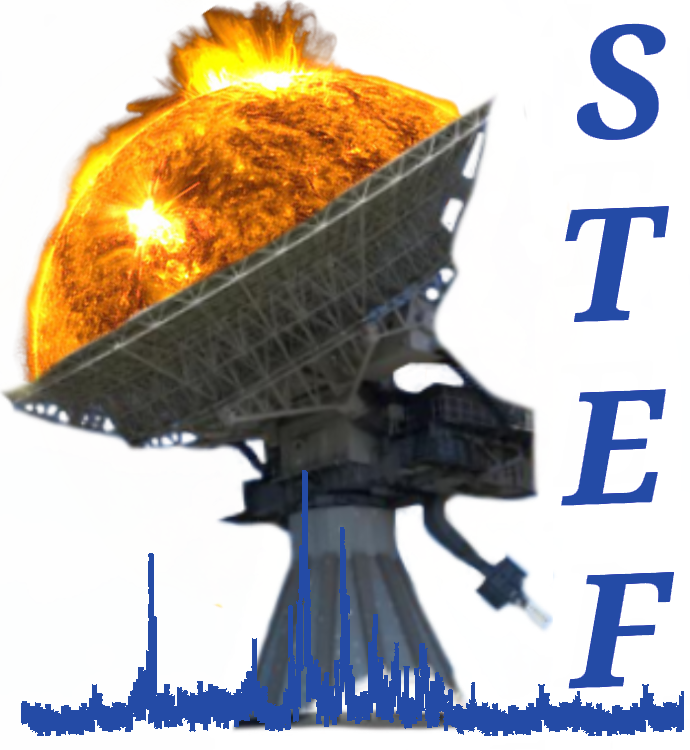This web page is created within BALTICS project funded from the European Union’s Horizon2020 Research and Innovation Programme under grant agreement No.692257.
About project STEF
„Multi-Wavelength Study of Quasi-Periodic Pulsations in Solar and Stellar Flares”
Project title: Multi-Wavelength Study of Quasi-Periodic Pulsations in Solar and Stellar Flares/Vairāku viļņu garuma kvaziperiodisku pulsāciju pētījums Saules un zvaigžņu uzliesmojumos
Project No.: lzp-2022/1-0017
Project acronym: STEF
Project logo:

Funder: Latvian Science Council, Fundamental and Applied Research Projects
Project submitter: Ventspils University of Applied Sciences (VUAS)
Project scientific supervisor: VUAS leading guest researcher Valeri Nakariakov
Duration: 01.01.2023. – 31.12.2025. (36 months, 3 reference periods)
Brief Qualitative Description and Aim of the Project:
Nowadays, research into the impact of space weather on the near-Earth environment, climate change, technology and other diverse aspects of modern human life is becoming increasingly important. Solar flares , which release coronal magnetic field energy, and coronal mass ejections are the major drivers of space weather and therefore have the most severe effects on the Earth's magnetosphere and near-Earth environment. It is evident that similar flare activity occurs on other solar-type stars, in the form of much more powerful superflares.
The project’s research programme focuses on a comprehensive multi-wavelength comparative observational study of the phenomenon of quasi-periodic pulsations (QPP), as signatures of oscillatory plasma dynamics, in the radio emission produced by solar flares and stellar superflares with the observational facilities at the Ventspils International Radio Astronomy Centre (VIRAC), Irbene, Latvia, in collaboration with colleagues from the University of Warwick, United Kingdom. The key aim is to establish a robust methodology for observing solar flares and stellar superflares in the radio band at VIRAC, reveal differences and similarities in the radio emission mechanisms of solar and stellar flares, and of characteristic properties of QPPs, and seed the ground for future follow up studies of solar and stellar flares in collaboration with radio observatories worldwide. Radioastronomical observations will be carried out in both polarisations in the 4.5-8.8 GHz band corresponding to the typical gyrosynchrotron emission in the solar corona, with Irbene radiotelescopes RT-32 and RT-16 in both single dish and interferometer modes. The stellar objects of interest are highly active flaring red dwarfs. The detection and analysis of QPP in light curves will be carried out with the use of the combination of traditional and innovative time-series analysis techniques, such as wavelets and Empirical Mode Decomposition. The expertise in the background theory and original approaches to data analysis is provided by the UK participants. The forward modelling of expected observables will be performed with the use of existing and well-tested numerical codes.
Key project tasks:
- To use two radio telescopes, RT-16 and RT-32, situated in Irbene, Latvia for employing a single-baseline interferometer capable of conducting an internationally competitive research programme in the field of solar and stellar flares in the radio band.
- To create and optimize a data analysis toolkit for the assessment of flare light curves and spectra and detection of QPP events, based on the data analysis routines previously designed/used by team members.
- To reveal differences and similarities between characteristic properties of solar and stellar flares and QPP events in them, using case study analysis and comprehensive statistical surveys.
- Broadly disseminate project results in the form of peer-reviewed publications in prestigious scientific journals, presentations at international and domestic conferences, running an annual international workshop on the topic of the project, public talks, and a science-popular article.
- Work with young scholars and students in the VIZIUM science and innovation Centre (Ventspils, Latvia).
Project results:
The expected project results will allow us to develop a unique research cluster at VIRAC, capable of performing observational and data analysis studies of solar flares and stellar superflares, at the level competitive with and/or supplementing the existing radio-band facilities. As a particular phenomenon of interest, intrinsic for both solar and stellar flare emissions, characteristic properties of QPP in the radio band will be revealed and used for establishing differences and similarities between physical mechanisms of solar flares and stellar superflares.
Scientific Results:
- Methodology of solar flare observations with a single dish on VIRAC radio telescope RT-32, (LNSP4) and in Sun-as-a-Star mode (L band).
- Methodology of stellar flare observations with a Irbene interferometer (RT-32 and RT-16, 4.5-8.8 GHZ band).
- Open access online catalogue of multiwavelength observations of solar and stellar flares.
- Radio-band QPP data analysis toolkit.
- Similarities and differences of radioemission of solar and stellar flares and of characteristic properties of QPPs.
Impact to society:
- Increasing public awareness of modern problems of space weather, solar flares and stellar superflares, and associated risks for our civilization.
- The promotion of STEM and enhancing interest in astronomy and radio systems.
- Development of technologies and data processing methods which could be effectively transferred from radio astronomy, interferometry and space weather applications to other branches of modern applied science.
- Promotion of VIRAC as a globally recognised astronomical facility.
Our project will deliver:
- 9 Peer-reviewed scientific publications and 1 science-popular article.
- 12 Contributions at conferences.
- 3 Press releases.
- 3 Annual online international workshops hosted by VIRAC.
Project funding: 300 000.00 EUR
Contacts:
Project PI – Prof Valeri Nakariakov, V.Nakariakov@warwick.ac.uk
Project co-PI Dr. Dmitrii Kolotkov, D.Kolotkov.1@warwick.ac.uk
Project researcher - MSc Vladislavs Bezrukovs,
vladislavs.bezrukovs@venta.lv



















